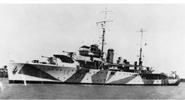Painting army vehicles with high contrast geometric patterns – ‘dazzle camouflage’ – affects the perception of their speed and thus could make them less susceptible to rocket propelled grenade attacks, according to new research from the University of Bristol.
Warships in both the First and Second World Wars were painted with dazzle camouflage: startling geometric patterns aimed at confusing the enemy rather than concealing the vessel. It was thought that such patterning would disrupt the enemy’s perception of a ship’s range, heading, size, shape and speed, thus reducing losses from torpedo attacks by submarines. While there were good reasons to believe that these perceptual distortions occurred, the effectiveness of dazzle camouflage was never scientifically proven.
The Bristol study, an interdisciplinary collaboration between the Schools of Experimental Psychology and Biological Sciences, led by Dr Nick Scott-Samuel, is the first to find evidence that dazzle camouflage can affect perception of speed – but only if the camouflaged object is moving quickly.
These findings suggest that, while it would probably not have successfully distorted ships’ speeds in the two World Wars, dazzle camouflage could play a role in today’s battlefields where fast-moving army vehicles frequently come under attack from shoulder-launched, rocket-propelled grenades.
Our perception of speed is affected by many disparate factors: for example larger objects appear to move more slowly than smaller objects, changes in contrast alter perceived speed, and differently oriented textures can be seen as moving at different speeds. Any of these effects could be elicited by dazzle patterning.
Dr Scott-Samuel and colleagues showed their experimental participants two moving patterns on a computer screen, and asked them to report which one moved faster. One pattern was always plain and the other was selected from a typical range of textures used in dazzle camouflage: stripes, zigzags and checks. The stimuli moved either slowly or quickly, and could be either low or high contrast.
When moving quickly, two of the high contrast patterns caused a significant reduction in perceived speed of around 7 per cent. These patterns – zigzags and checks – were two-dimensional, in contrast to the other, one-dimensional, patterns tested. Patterns which were less visible (low contrast) or slow moving had no effect on perceived speed; the former finding indicates that the effect is not simply due to texture per se, and implies that straightforward background-matching camouflage (which is generally lower contrast) would not produce a speed distortion. High contrast texture, as used for dazzle camouflage, is necessary.
Dr Scott-Samuel said: “The effect should obtain in predators launching ballistic attacks against rapidly moving prey, or on modern, low-tech battlefields where handheld weapons are fired from short ranges against moving vehicles. In the latter case, we show that in a typical situation involving an RPG7 attack on a Land Rover the reduction in perceived speed would be sufficient to make the grenade miss where it was aimed by about a metre, which could be the difference between survival or otherwise for the occupants of the vehicle.”
Paper
‘Dazzle camouflage affects speed perception’ by Nicholas E. Scott-Samuel, Roland Baddeley, Chloe E. Palmer and Innes C. Cuthill in PLoS One
